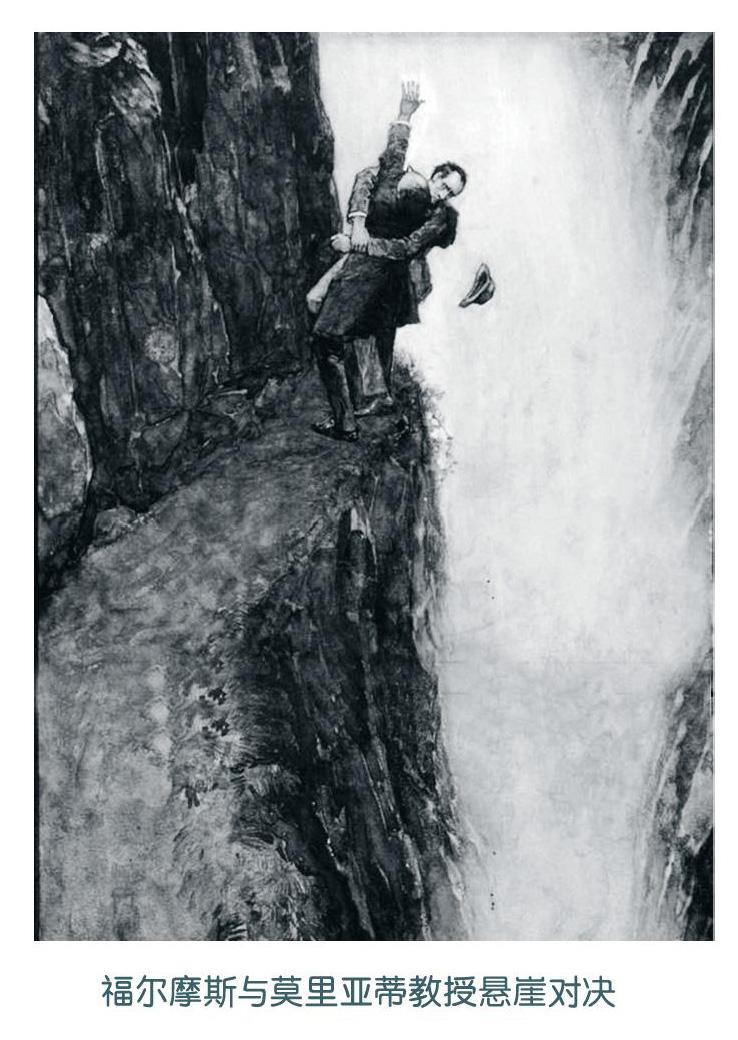福尔摩斯如何改变世界
2016-05-14晨尘
晨尘


How Sherlock Holmes Changed the World
By Jennifer Keishin Armstrong
英国广播公司出品的《神探夏洛克》无疑是当今最热门的电视剧之一,受到世界各地无数粉丝的热烈追捧。自第一则福尔摩斯故事出版至今已经120多年,而福尔摩斯热却一直没消退过,无数改编的影视作品不断出现,一代又一代的粉丝前仆后继。那么这其中的魔力究竟是什么呢?
1. 1893年,作家阿瑟·柯南·道尔把侦探夏洛克·福尔摩斯“推下”了悬崖。shove: 猛推。这里指的是柯南·道尔在《最后一案》(“The Final Problem”)中让福尔摩斯和死敌莫里亚蒂教授一同跌入深渊,以结束福尔摩斯的故事。
2. fictionally: 虚构地,杜撰地;Switzerland: 瑞士;Reichenbach Fall: 莱辛巴赫瀑布。
3.“怀着沉重的心情,我拿起笔写下这结局,这是我最后一次书写我的朋友夏洛克·福尔摩斯先生那非凡的天赋,这让他成为了如此杰出的人物,”在柯南·道尔的《最后一案》中,叙事人约翰·华生如是说。这个故事于1893年12月被登载在《海滨杂志》上。singular: 突出的,非凡的;distinguished: 杰出的,卓越的。
4. 你可以想象柯南·道尔后梳的头发在烛光中微微发光,他欣喜地捻着他浓密的胡子。slicked-back: 后梳式的;shimmer: 闪烁,发微光;twirl: 捻弄,卷曲;ample: 丰富的,充足的;glee: 快乐,欢喜。
5. “我写这个角色过多了,感觉就像有次我吃太多鹅肝酱而吃伤了一样,时至今日我听到‘鹅肝酱三个字都感到反胃。”overdose: 过量;paté de foie gras: 鹅肝酱。
6. 当决定停止出版夏洛克故事时,柯南·道尔可能想这样结束就结束了吧。in print: 已印出,已出版。
7. 公众对于夏洛克之死的反应在小说史上是前所未见的。
8. 多达两万多名《海滨杂志》的读者被福尔摩斯的早亡所激怒,并取消了杂志订阅。outrage: 引起……的义愤,激怒;premature: 提早的,过早的;demise: 死亡。
9. dreadful: 可怕的,糟糕的。
10. 有传言说在福尔摩斯去世当月,伦敦随处可见年轻人在帽子或手臂上佩戴黑纱以示哀悼,尽管这一传言最近受到了质疑。mourning: 哀悼;crêpe: 绉纱,绉绸。
11. brute: 畜生,残暴的人。
12. 面对这些抗议,柯南·道尔依然坚持己见,声称让福尔摩斯死去是“正当杀人”——当然,这应该是为他自己的辩护,而非莫里亚蒂教授。stick to ones guns: 坚持己见;justifiable: 正当的,情有可原的;homicide: 杀人行为,杀人犯;presumably: 可能,大概;justification: 辩解,正当理由。
13. a/the torrent of: 大量,许多(尤指令人不快的东西);vitriol: 刻薄话,尖锐批评。
14. fanatic:(政治或宗教的)狂热信徒;enthusiast: 热衷者,爱好者。
15. conform to: 符合,遵照。
16. reciprocal: 相互的,互惠的。
17. frenzy: 狂热,疯狂。
18. 夏洛克·福尔摩斯狂热的读者创造了现代的追星行为。avid: 热衷的,热心的; fandom: 电视迷,影迷。
19. 有趣的是,福尔摩斯热延续至今,催生了无数再创作的虚构作品,比如美国的破案连续剧《基本演绎法》和英国广播公司的《神探夏洛克》,后者在元旦当天推出万众期待的特辑,现代版的夏洛克和华生穿越回到维多利亚时期。spawn: 引起,大量产生。
20. novelette: 短篇小说;A Study in Scarlet: 《血字的研究》。
21. 福尔摩斯一经推出就大受欢迎,以至于不久柯南·道尔便后悔创造了这个人物,因为福尔摩斯小说使得柯南·道尔心目中的严肃作品完全黯然失色,比如他的历史小说《弥迦书·克拉克》。overshadow: 使失色,使相形见绌。
22. newsstand: 报纸摊,报刊亭。
23. Queen Victoria: 维多利亚女王(1819—1901),是英国历史上在位时间第二长的君主,她在位的64年期间(1837—1901)是英国最强盛的“日不落帝国”时期。
24. Sir Walter Scott: 沃尔特·司各特爵士,英国著名的历史小说家和诗人。他以苏格兰背景诗歌而闻名,但拜伦出现后,他意识到无法超越,因此开始创作历史小说,并成为英国历史文学的一代鼻祖。
25. 他坚持8年不写福尔摩斯的故事,但到了1901年,公众压力实在太大,以至于柯南·道尔又写了一则新故事《巴斯克维尔的猎犬》,讲述福尔摩斯跌落山崖前的事情。feature: 特写,以……为主要内容。
26. 1903年,他又写了一篇《空屋》,小说里福尔摩斯复活了,并解释说当时只有莫里亚蒂在跌落山崖后死掉了,而福尔摩斯只是装死。resurrect: 使复活。
27. rejoice: 欢喜,感到高兴。
28. obsessive: 着迷的,沉迷的。
29. 即便如此,英国广播公司的《神探夏洛克》电视剧一时间便激起了福尔摩斯影迷们的激情与狂热。stoke: 添加燃料,烧火;strand:(线、绳的)股,缕。
30. 本尼迪克特·康伯巴奇饰演现代版福尔摩斯,该剧粉丝经常光顾夏洛克和华生(马丁·弗瑞曼饰演)喜欢去的那家三明治店——“史皮迪斯咖啡屋”。frequent: v. 经常去。
31. 有时候,制片人会创造一些场景以投粉丝所好,比如在一部三集电视连续剧中,第一集整集就建立在粉丝关于夏洛克假死的想象上,这也是对《空屋》的再现。wink at: 使眼色;episode:(电视剧或广播剧的)一集。
32. 值得注意的是,夏洛克·福尔摩斯的粉丝沉迷于这个虚构的侦探故事长达120多年,中间经过许许多多的改编。histrionics:(用作单数)戏剧表演,演戏;adaptation: 改编。
33. thereafter: 在那之后,此后。
34. onwards: 从……以后;draw a line from: 模拟,模仿。
35. Agatha Christie: 阿加莎·克里斯蒂(1890—1976),英国著名女侦探小说家、剧作家;explicitly: 清楚地,明白地;Poirot: 赫尔克里·波洛,是克里斯蒂笔下著名的侦探人物,和下句中的黑斯廷斯上尉(Captain Hastings)是好友和搭档;as opposed to: 与……相反的。
36. imperishable: 不灭的,不朽的。
37. 纵观现在电视上出现的各种英雄人物,大体上都采用福尔摩斯的那种模式——智力超群却又存在性格缺陷。landscape: 全貌;play on: 对……加以利用;formula: 方法,方案。
38. 我想道尔开启了这样一种认识:超级天才总是以某种社会功能的缺失为代价,就算是在侦探之外的领域也是如此,之后人们便将这种思路看成一种叙事可能。dysfunction: 机能障碍;grasp: 理解,领会。
39. see to it: 保证,务必做到。
In 1893, author Sir Arthur Conan Doyle shoved detective Sherlock Holmes off a cliff.1 The cliff was fictionally located in Switzerland, over the Reichenbach Falls.2 But Conan Doyle did the dirty work from his home in London where he wrote. “It is with a heavy heart that I take up my pen to write these the last words in which I shall ever record the singular gifts by which my friend Mr. Sherlock Holmes was distinguished,” narrator Dr. John Watson says in Conan Doyles story “The Final Problem”, which appeared in The Strand Magazine in December 1893.3
Conan Doyle himself seemed a little less emotional in private. “Killed Holmes,” he wrote in his diary. One can imagine Conan Doyle, slicked-back hair shimmering in the candlelight, twirling his ample mustache with glee.4 He later said of his famous character: “I have had such an overdose of him that I feel towards him as I do towards paté de foie gras, of which I once ate too much, so that the name of it gives me a sickly feeling to this day.”5
Conan Doyle may have thought, at the time of finishing Holmes off in print, that that was that.6 If he did think this, he did not understand fans—particularly fans of Holmes—very well. The public reaction to the death was unlike anything previously seen for fictional events.7 More than 20,000 The Strand readers cancelled their subscriptions, outraged by Holmes premature demise.8 The magazine barely survived. Its staff referred to Holmes death as “the dreadful9 event”.
Legend has it that young men throughout London wore black mourning crêpes on their hats or around their arms for the month of Holmes death, though that has recently been questioned.10 Outraged readers wrote to the magazine in protest: “You brute11!” one letter addressed to Conan Doyle began. Americans started “Lets Keep Holmes Alive” clubs. Conan Doyle stuck to his guns in the face of the protests, calling the death “justifiable homicide”—referring, presumably, to his own justifications, not Moriartys.12
This sounds, of course, like just another day on the internet in 2015. But at the time, Conan Doyle had every reason to be shocked by the torrent of vitriol.13 Fans simply did not do this before then. (In fact, they werent even called “fans” yet. The term, short for “fanatic”, had only recently begun use in reference to American baseball enthusiasts.)14 Readers typically accepted what went on in their favourite books, then moved on. Now they were beginning to take their popular culture personally, and to expect their favourite works to conform to15 certain expectations. They seemed to actually expect a reciprocal16 relationship with the works they loved.
Fan frenzy17
Sherlock Holmes avid readers helped to create the very modern practice of fandom.18 Interestingly enough, Holmes intense following continues to this day, spawning endless reimaginings, such as the US crime-solving series Elementary and the BBCs Sherlock, which returned with a highly-anticipated special on New Years Day, its modern-day Sherlock and Watson returning to Victorian times.19
Holmes first appeared in 1887, in the novelette A Study in Scarlet.20 He was popular from the start—so popular that soon Conan Doyle began to regret having created him, since Holmes stories so completely overshadowed what Conan Doyle considered his serious work, such as his historical novel Micah Clarke.21 Readers lined up at newsstands22 for The Strand on publication day whenever a new Holmes story was to appear inside. Because of Holmes, Conan Doyle was, one historian wrote, “as well-known as Queen Victoria23”.
The demand for Holmes stories seemed endless. The Strand would pay Conan Doyle nicely for whatever he could give them. But he hadnt meant to spend the rest of his life inventing and solving fictional crimes. Hed meant to make some money to support his real art, novels full of what he felt were important ideas and political statements.
By 1893, when Conan Doyle was 34, hed had enough. He wanted to be Sir Walter Scott24. So he had the evil Professor Moriarty push Holmes down the falls. It took eight years, but by 1901, however, public pressure grew so great that Conan Doyle wrote a new story, The Hound of the Baskervilles, featuring Holmes before his fall.25 In 1903, in The Adventure of the Empty House, he went one step further, resurrecting Holmes with the explanation that only Moriarty had died in the fall, while Holmes had faked his own death.26 Fans rejoiced27.
Life after death
Holmes fans have only grown more obsessive28 since then. The only difference is that now were used to super-fandom. Even so, the BBC series Sherlock, in particular, has stoked the most passionate strand of Holmes fandom in some time.29 Fans of the show, which stars Benedict Cumberbatch as a modern-day Holmes, frequent the London sandwich shop favoured by Sherlock and his Watson (Martin Freeman), Speedys Café.30
As a TV show, Sherlock has maintained a complicated relationship with its fans. Sometimes the producers throw in a scene to wink at fans—or in the first episode of series three, an entire episode built out of fan theories about how Sherlock faked his own death, also a callout to The Adventure of the Empty House.31
Of course, Sherlocks ability to cause such intense emotion among its fans is only an indication of how much they love it. Whats remarkable is that Sherlock Holmes fans have been engaging in such histrionics over the fictional detective for more than 120 years, through many, many adaptations.32
Sherlock co-creator Mark Gatiss, who also plays the detectives brother Mycroft, points out that Holmes is one of the original fictional detectives—most other crime-solvers created thereafter33 were copies of him or a direct reaction to him: “Everything onwards is people drawing a line from Sherlock and Doctor Watson.34 Agatha Christie does it explicitly and makes Poirot short and round as opposed to tall and lean.35 He needs a Watson, so she creates Captain Hastings. Everywhere you go, this is the model. Thats why its imperishable36 I think.”
Just look at the landscape of current TV heroes, many of which play on Holmess brilliant-but-damaged formula.37 “Even outside the world of detection, I think Doyle began the idea that super-intelligence comes at the price of some kind of social dysfunction, something that weve grasped as a narrative possibility ever since,”38 Steven Moffat, the shows co-creator, has said. “Hes a genius, therefore hes a bit strange. I dont know how often that happens in real life, but it happens a lot in fiction.”
In other words, pushing Sherlock Holmes off a cliff has no chance of killing him. Hell always come back, in this lifetime and the next. The fans will see to it39.
